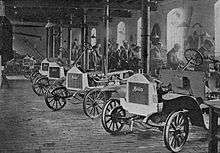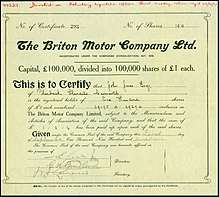Briton Motor Company
The Briton Motor Company was a Wolverhampton-based car manufacturer that produced cars from 1909 to 1919 then from 1922 to 1929. The company produced a number of models ranging from 7 to 16 horsepower and played an important role in the Wolverhampton motor industry.

History
Foundation
The Briton Motor Company was formed in 1909 after the Star Engineering Company took over the Star Cycle Company and manufacture of the 'Starling' and 'Stuart' cars was ended. They were replaced by Briton cars produced by the Briton Car Company, managed by Edward Lisle Junior, son of Star's founder.[1] Briton continued to work out of Star's Stewart Street Works using the same workforce as had been there previously. The first model produced was the two-cylinder, 7 hp, 'Little Briton' which sold for 175 guineas, increasing to 10 and 12 hp. These were followed by four-cylinder models ranging from 12 to 16 hp.[2]
In 1912 the Briton Motor Company (1912) Limited was formed and moved to a new site on lower Walsall street, previously occupied by Shrubbery Iron Works, in 1913. The company took part in many trials across 1912–1913, winning gold and silver medals in the trials at Brooklands, Saltburn and Manchester.[1]
The First World War
Car production continued during the war although Briton did contribute to the war effort by making shell cases. The company also became UK agent for the American Scripps-Booth car, but the venture failed. 1914 and 1915 saw the introduction of new two- and four-seater models with a new deluxe chassis.[3]
In 1917 and 18 only small commercial vehicles and ambulances were produced. However, the company found itself in trouble with the government for failing to meet its contractual obligations. The government demanded compensation which resulted in a call for shares of £50,000.[1]
The end of the company

Production resumed in 1919 with the release of 10/12 hp. car, powered by a four-cylinder engine which sold for 420 guineas. They produced 106 of this model, along with 549 of the 14/16 hp cars. The company was able to raise £50,000 through the sale of shares, and in 1920 three new models were designed, including a Chapuis Dornier-engined sports car although none ever went into production.[1]
Briton produced 170 cars during 1920, 163 of the 10/12 hp. model and 7 of the 10 hp. model. However, the car industry was changing as companies such as Austin and Morris adopted mass-production techniques, meaning they were able to produce and sell cars at a cost that Briton could not match, putting the company in deep financial trouble.[4]
In December 1920 the Midland Bank took £50,000 worth of Briton's stock as repayment of debts owed to them, and the company produced only 65 cars in 1921. In December 1921 the bank appointed receivers for the company, and a month later the company entered liquidation, assessed at a value of £30,500. Britons's works were sold to fellow Wolverhampton company AJS in October 1923 for £7,000.[2]
The Briton Motor Company name was carried on by Charles A. Weight, who took over what remained of the company. Weight moved the machine shop and components that had been left behind to a new site at Chillington Fields, also taking on a number of Briton's old workforce. Car production continued on this site until 1929, when production costs became too great, with around 600 cars having been made in total. The Briton Motor Company continued, becoming Tractor Spares Limited in 1940, a company which still exists today.[1]
Car models
| Year of release | Specifications | Features | Price |
|---|---|---|---|
| 1909 | 7/10 hp. 2-cylinder | 2-seater | 175 Guineas |
| 1910 | 12/14/16 hp. 4-cylinder | 2-seater | 200 Guineas |
| 1912 | 10/12 hp. 4-cylinder car | 2-seater streamlined body | 235 Guineas |
| 1912 | 10/12 hp. 4-cylinder car | 4-seater streamlined body | 255 Guineas |
| 1912 | 10/12 hp. 4-cylinder special car | 2-seater streamlined body | 175 Guineas |
| 1912 | 14/16 hp. 4-cylinder special car | 2-seater streamlined body | 200 Guineas |
| 1912 | 14/16 hp. 4-cylinder special car | 4-seater streamlined body | 220 Guineas |
| 1912 | 14/16 hp. 4-cylinder car | 2-seater streamlined body | 310 Guineas |
| 1912 | 14/16 hp. 4-cylinder car | 4-seater streamlined body | 350 Guineas |
| 1913 | 10/12 hp., 4-cylinder, 68 mm bore x 120 mm stroke, 1,743 cc at 1,000 rpm | Standard chassis, pointed radiator | 190 guineas |
| 1913 | 10/12 hp., 4-cylinder, 68 mm bore x 120 mm stroke, 1,743 cc at 1,000 rpm | 2-seater | 235 guineas |
| 1913 | 10/12 hp., 4-cylinder, 68 mm bore x 120 mm stroke, 1,743 cc at 1,000 rpm | 4-seater | 255 guineas |
| 1913 | 10/12 hp., 4-cylinder, 68 mm bore x 120 mm stroke, 1,743 cc at 1,000 rpm | Special chassis, flat radiator | 160 guineas |
| 1913 | 10/12 hp., 4-cylinder, 68 mm bore x 120 mm stroke, 1,743 cc at 1,000 rpm | 2-seater | 175 guineas |
| 1913 | 10/12 hp., 4-cylinder, 68 mm bore x 120 mm stroke, 1,743 cc at 1,000 rpm | 4-seater | 200 guineas |
| 1913 | 14/16 hp., 4-cylinder, 80 mm bore x 120 mm stroke, 2,412 cc at 1,000 rpm | Standard chassis, flat radiator | 225 guineas |
| 1913 | 14/16 hp., 4-cylinder, 80 mm bore x 120 mm stroke, 2,412 cc at 1,000 rpm | 2-seater | 310 guineas |
| 1913 | 14/16 hp., 4-cylinder, 80 mm bore x 120 mm stroke, 2,412 cc at 1,000 rpm | 4-seater | 350 guineas |
| 1913 | 14/16 hp., 4-cylinder, 80 mm bore x 120 mm stroke, 2,412 cc at 1,000 rpm | Special chassis, pointed radiator | 180 guineas |
| 1913 | 14/16 hp., 4-cylinder, 80 mm bore x 120 mm stroke, 2,412 cc at 1,000 rpm | 2-seater | 200 guineas |
| 1913 | 14/16 hp., 4-cylinder, 80 mm bore x 120 mm stroke, 2,412 cc at 1,000 rpm | 4-seater | 220 guineas |
| 1914 | 14/16 hp., 4-cylinder | 2-seater Special Car | 200 guineas |
| 1914 | 14/16 hp., 4-cylinder | 4-seater Special Car | 220 guineas |
| 1915 | 10/12 hp., 4-cylinder | Wide 2-seater | 190 guineas |
| 1915 | 10/12 hp., 4-cylinder | Roomy 4-seater | 215 guineas |
| 1915 | 14/16 hp., 4-cylinder | 2-seater plus dickey De Luxe car | 330 guineas |
| 1915 | 14/16 hp., 4-cylinder | 4-seater De Luxe car | 370 guineas |
| 1919 | 10/12 hp., 4-cylinder, 1,375 cc engine, 63 mm bore, 110 mm stroke | 4-seater | 420 guineas |
References
- Wolverhampton History and Heritage, Briton Cars Archived 27 October 2011 at the Wayback Machine, Retrieved 9 September
- Collins, Paul & Stratton, Michael, "British Car Factories from 1896", Veloce Publishing, ISBN 1-874105-04-9
- Lord Montagu of Beaulieu, "Lost Causes of Motoring" Cassell & Company Ltd., 1960
- The Motor Car Journal Volume 12, Cordingley & Co, 1910